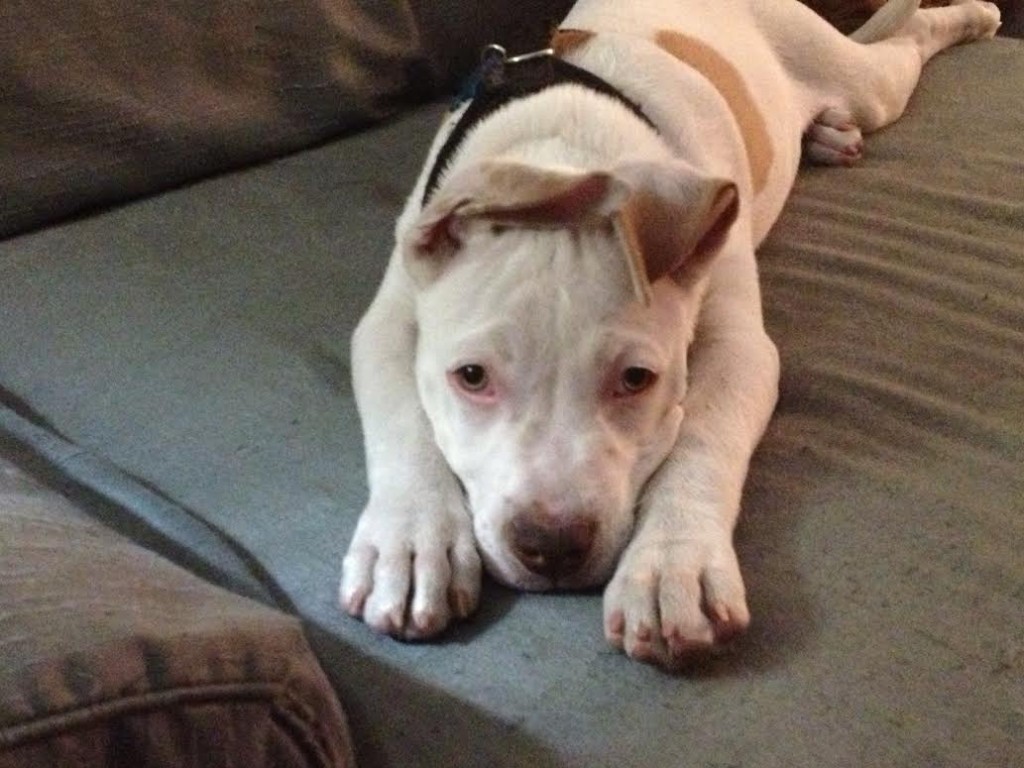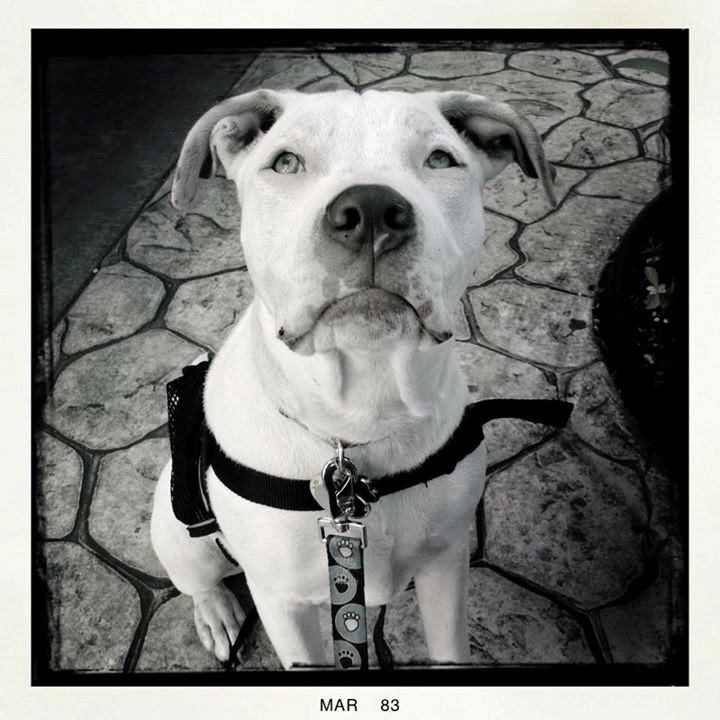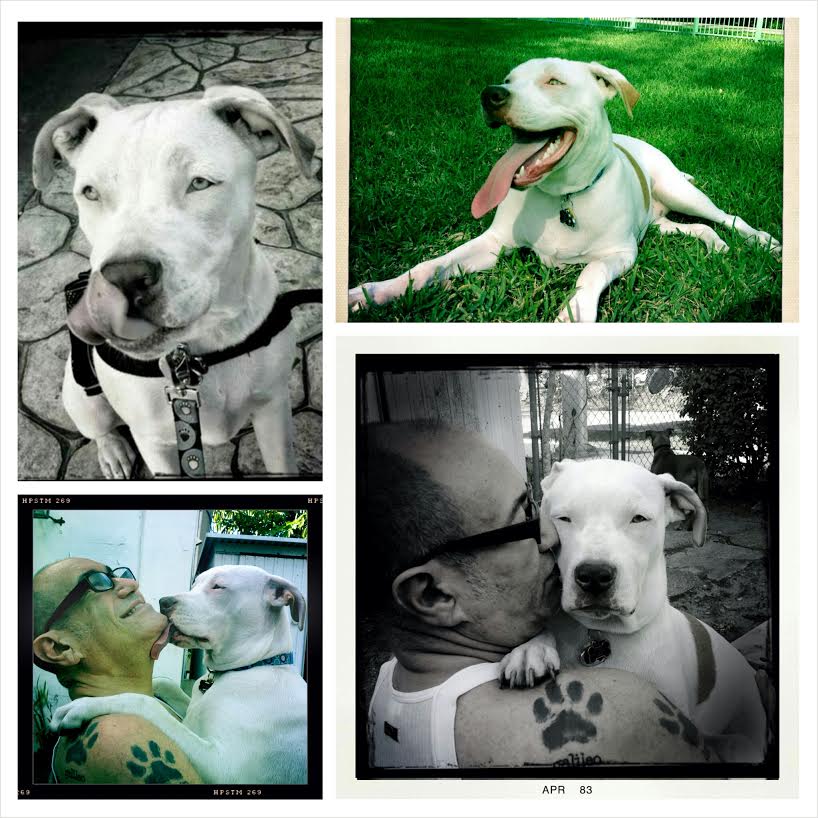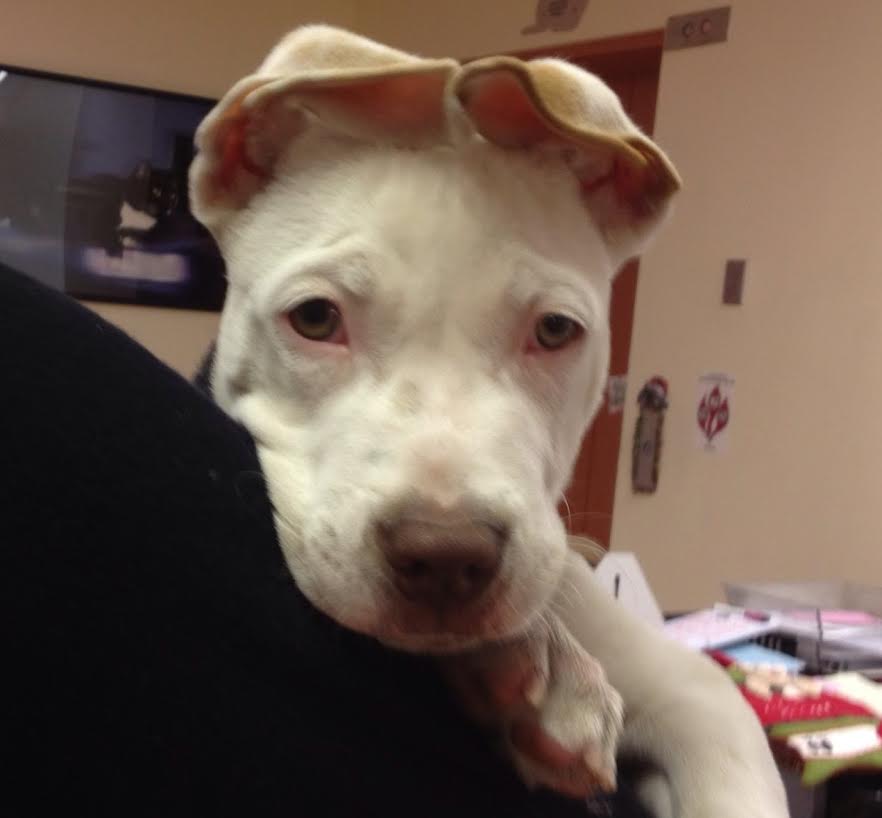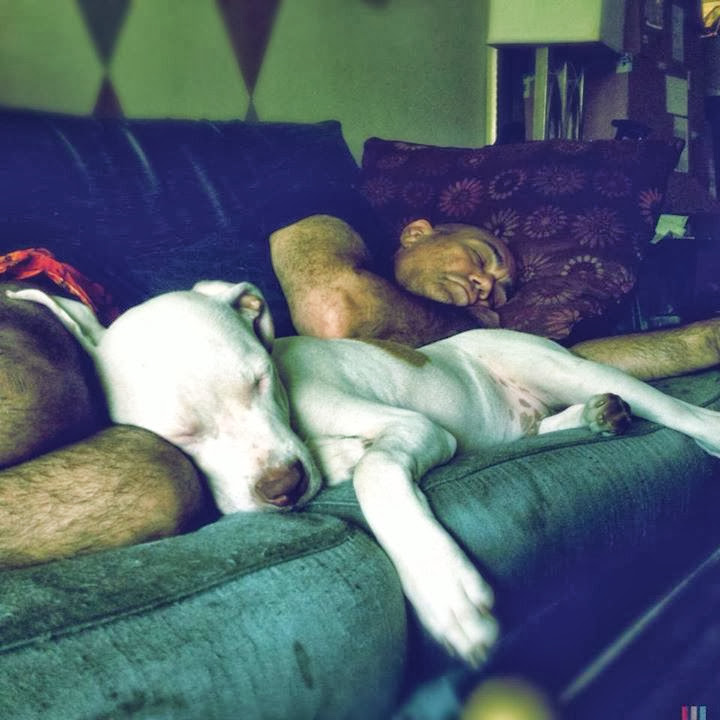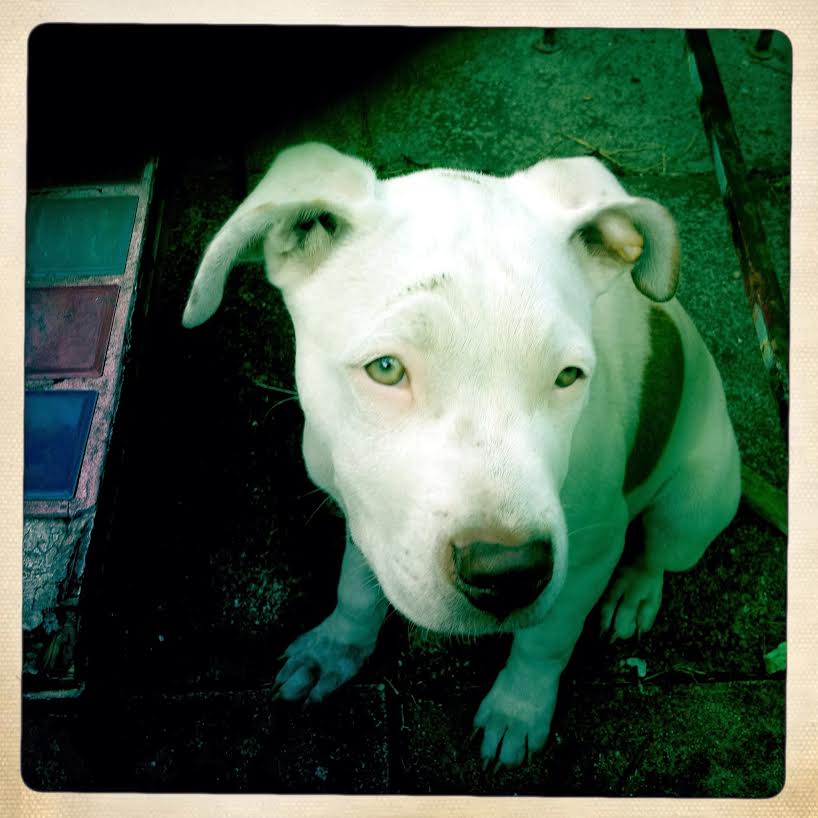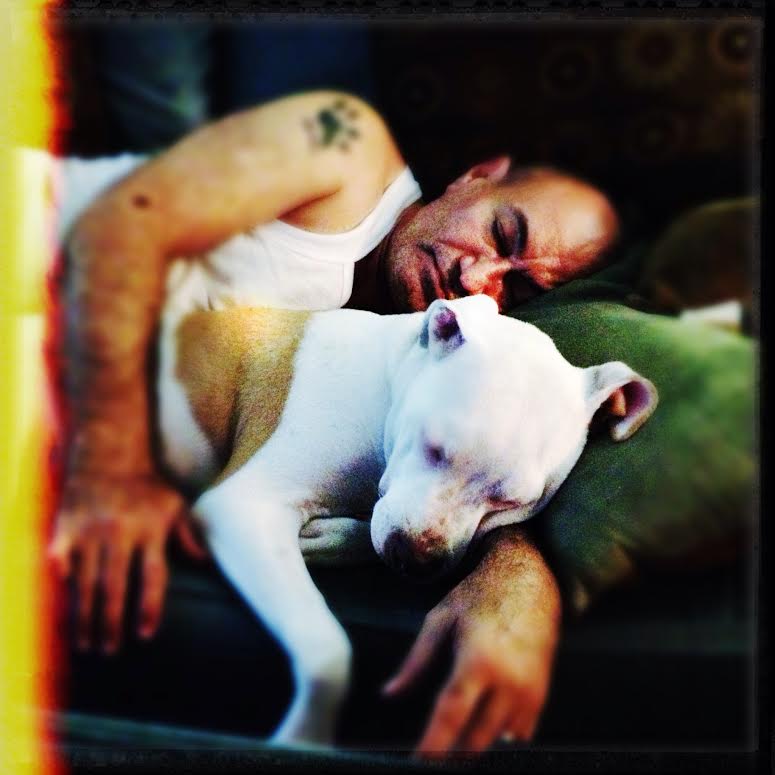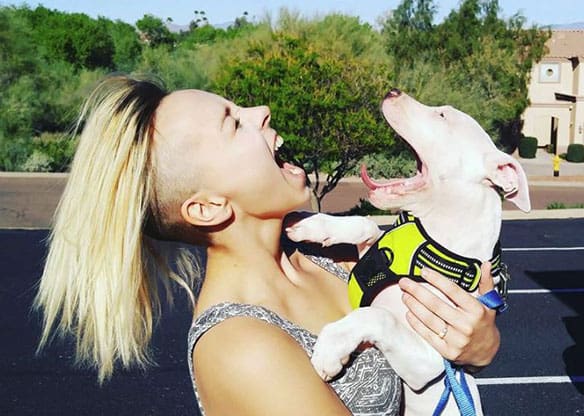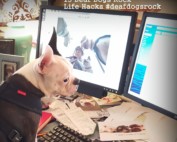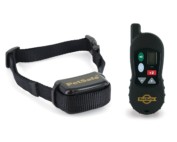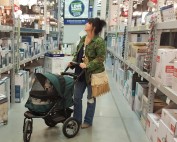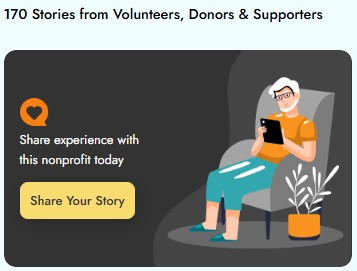Please welcome our guest blogger Bernard – Lima Chavez. Bernard is one of our deaf dog advocates down South in the Miami, FL area. We became friends a few years back when he used to be a Vet Tech for The Humane Society of Greater Miami. Bernard and his husband Omar are “owned” by two deaf dogs, several hearing dogs, and a couple of kitty cats. This guest posts is about their experience when they first welcomed deaf dog Edison into their home.
Bernard has a ROCKIN blog called thegraffitidog.com/blog/ which I just love. He is such a natural writer and his posts are heart felt and entertaining. Lately he has been covering the amazing urban art scene in Wynwood Art Walk in Miami.
Please welcome Bernard to Deaf Dogs Rock!
~ Happy reading, Christina Lee – Deaf Dogs Rock
Learning to Speak (Deaf) Dog by Bernard-Lima Chavez
When we first met our deaf dog Edison, my husband and I were most definitely not looking for another dog, and a ten-week old, deaf Dogo Argentino/Pit Bull puppy was even further down on our “to-do” list. Way down. Somewhere between a root canal and inviting my mother to come for a visit.
We were quite sure (well, he was anyway) that our home was full and our family complete. At the time, we were sharing our lives with two large dogs, five cats and a small yet demanding lovebird. My husband also has a pig; my name is Bernard. I am prone to leaving things precisely where I finish using them. Underwear on the stove? Coffee mug doubling as an ashtray? Check and check. I only mention this to emphasize my greater point: ten critters from four different species living harmoniously under one roof takes work; doing so without violating municipal health codes when one partner lives like a frat boy requires time, and a lot of it. To add a puppy to the mix, but especially a deaf puppy, would take up even more time, and frankly we weren’t sure we had it to spare.
Wall art by @kraveart
Our lives are ruled by wicked work schedules. Both of our careers are demanding with a lot of bleed-over into our personal lives. In theory, we understand the concept of a home-work life balance but we just don’t have a whole lot of experience. He travels approximately three weeks out of the month for work, whereas I manage the brand campaigns for brands in the pet industry which means I am always working: at lunch, in the shower, during supper.
I’m not sure how rational the process of adopting a deaf dog is, or at least how rational it was for us. We had lots of very good, logical reasons not to bring him home. We weren’t sure that our small pool of available time would be enough to meet his needs. We had already lost our bed and couch to Darwin, sixty pounds, and Galileo, seventy pounds. Though not tiny, our house could never be described as expansive. Galileo had just gotten to an age where his puppy brain would yield, at least most of the time, to his adult brain and he no longer ate the couch. We were living halcyon days, with no fear of discovering that the remote control was firmly lodged in his gastrointestinal tract. Bringing home a puppy now would mean we were going to start all over, just when things were getting back to normal again. We could have spent days coming up with reasons not to adopt Edison, but the fact remained that he spoke to us.
We were drawn to him and, in our gut, we instinctively knew that he was our dog. His presence immediately added something to the house that we never knew was missing. His energy felt familiar, familial even. He belonged with us, and we with him. As I said, not very rational but incredibly powerful nonetheless. Life changing, in fact, and it was immediate.
Though he had come home for the weekend as a “foster”, thirty minutes after meeting Edison, my husband was googling famous deaf male scientists/academics– we had theme going and, by God, we gays love a theme.
Those first days and weeks were terrifying, punctuated by moments of excitement, exhilaration and awe. A deaf puppy?! What were we thinking? Neither of us could remember ever meeting a deaf dog, and certainly had never considered living with one. And training? Gulp!
For context, you should know that my husband didn’t have his first dog until he was in his forties so his knowledge of dog training is not very broad. He’s a quick study and has the basics down, but a deaf dog presents a whole different set of challenges. As a veterinary technician working in shelter medicine, I’m sure that I must have encountered deaf dogs without realizing it. Common sense and quickly running the intake and adoption numbers at my shelter over the past three years tell me that, certainly, I must have interacted with at least one or two deaf dogs. However, neither my work experience nor my education provided me with any foundation to build on or adapt to deaf dogness and I had some serious doubts about my ability to do so. How are we going to tell him, “No”?
We spent the first few weeks living in our search engines, combing the internet for information about deaf dogs. We were hungry for training tips, videos, stories from other people who had lived successfully with deaf dogs. Any information we could find tasted like manna to us and sated, even momentarily, our need for as much information as we could store. Sure, we wanted to equip ourselves with what we needed to know, but we also wanted encouragement. We didn’t want things white-washed but we did want to know, to feel, that we could do this. We needed to know that it was possible retrain our brains to communicate only with our hands, our bodies, and not rely on our voice- you know, like a dog.
After all, communicating with a deaf dog is much like switching on our canine-brain. A year after adopting Edison, I now know to tell every potential adopter of a deaf dog that, in many ways, training a deafie is easier. By talking with our hands, we are closer to speaking to our dogs in a language that makes much more sense to them. Once you realize that the vast majority of canine communication is non-verbal, the idea of primarily using your body to express yourself doesn’t seem so daunting. Sure, dogs do vocalize. They huff, they growl and they bark-but only after a whole series of non-verbal communication has taken place. Once you connect these dots, the whole process is no longer terrifying, it is exciting.
On a side note, people who share their lives with deaf dogs frequently say that there is a deeper, almost psychic connection between themselves and their dogs. I wonder if this has to do with the fact that both human and dog are listening to each other more, speaking something closer to a common language. I know that for me personally, I now pay much more attention to my dogs’ body language than I ever did before Edison. I am beginning to speak their language, or at least I am now listening better to what they are telling me. When we are using a common, unspoken language, of course the relationship seems more intuitive.
One of the sources that my husband and I most consistently came back to in those first few weeks (and today for that matter) is Deaf Dogs Rock. It is, hands-down, the most comprehensive source of practical yet palatable information on almost every aspect of a life lived with a deaf dog that I have found. The training tips are great, but the training videos are indispensable. The list of other resources is the most complete I’ve come across. The community of people living the same unique experience is reassuring and uplifting. And the tireless networking of homeless deaf dogs in need by the DDR community, but most especially it’s founders, Christina and Chris, is just plain awesomeness with a creamy, caramel center.
At work, I am grateful that they allow me to bring in homeless deaf dogs one or two at a time, train them and find them appropriate homes. In the past year, I have had at least one deaf dog at all times, with as many as four at one time, that were waiting to be adopted. When I meet with potential adopters, I make four suggestions: when you feel overwhelmed, and you will, take a breath, pick up an ASL pocket dictionary or download an app, never use your hands to punish or correct, and finally, connect with Deaf Dogs Rock. That is the best foundation I can give the adopter and the dog. I know that if the adopter follows these suggestions, I have set the dog up for success. Sure, there are lots of other important tips- safety considerations, techniques for avoiding startling or separation anxiety, dealing with the inevitable moron who insists your dog is not deaf when he responded to the movement of two hands clapping inches away from his head- but these issues are addressed by the community of deaf dog advocates that is Deaf Dogs Rock.
If you have just discovered your dog is deaf, if you have recently adopted a deaf dog, or if you are considering taking home that gorgeous hunk of beefcake dog that happens to be deaf but are unsure if you are up to the challenge, I assure you that you are. If you take this challenge to heart, if you read the experiences and reflections of others who are doing this, if you open your mind, take a breath and learn to be patient not only with your dog but also yourself, you will fly high. Thousands upon thousands of people already know what you are about to learn: deaf dogs listen with their eyes and they hear with their hearts- and so can you.


